By Rick VanSickle
Almost a year ago today, the 2020 wine vintage was being anointed as the most perfect year for wine Ontario had ever seen. And that was before a bottle had even been sold.
Also in this report, we have Ontario wine vintage charts all the way back to 1998. Plus, for a full review of the 2021 vintage, go here.
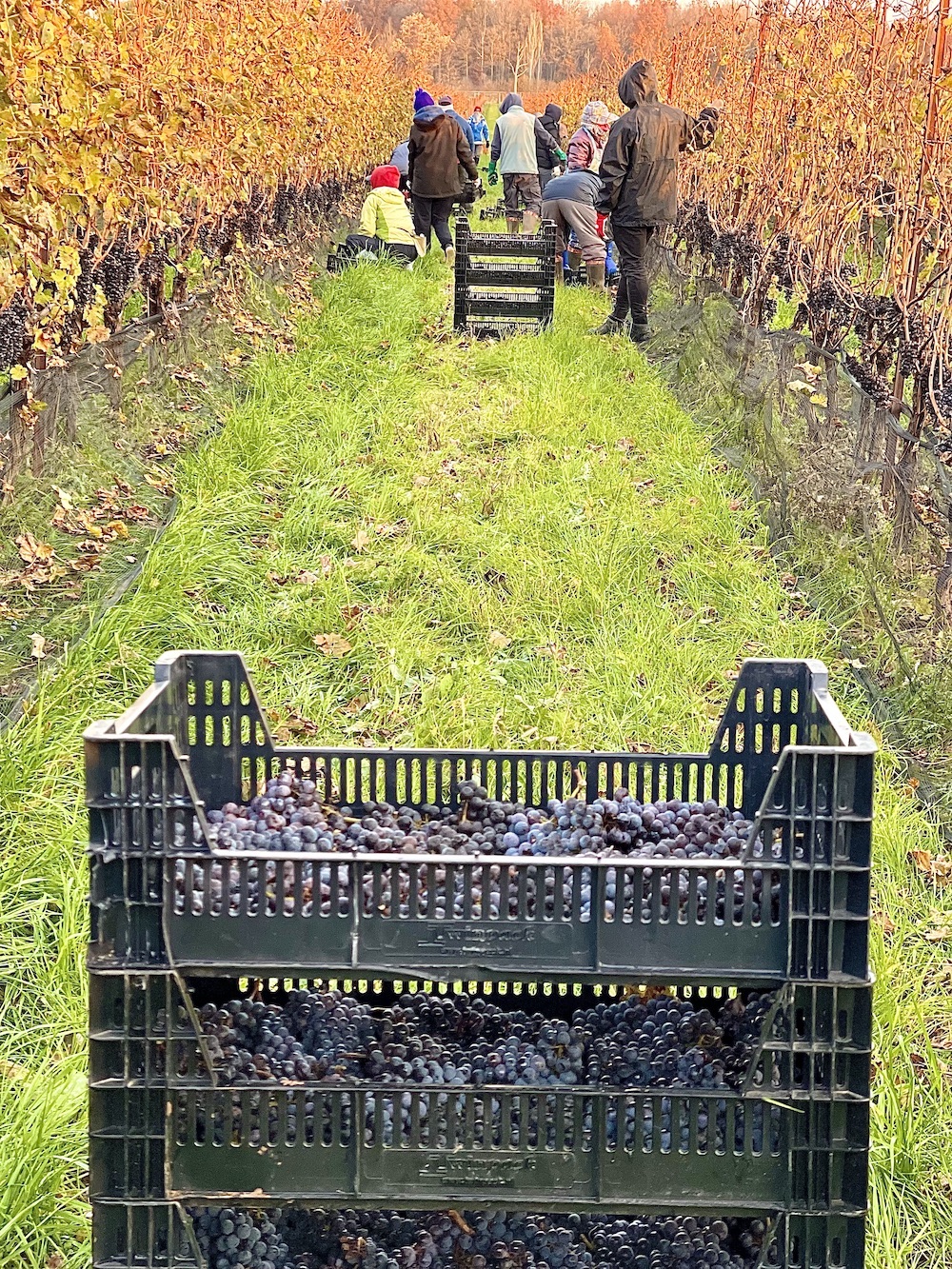
A year later, after tasting many of the 2020 wines, that sentiment still stands. There has never been a more perfect vintage than 2020 and it will take a lot to knock it off its lofty perch as the best ever. So many things must go right to find uniformity across all the diverse grapes grown in Ontario in a given vintage. That perfect 2020 grape-growing season unfolded to favour bigger reds, early ripening reds, whites and even the Gamays and Pinots. Everything seemed to work in 2020.
Then 2021 came along and teased winemakers with what looked like a repeat summer of 2020 with warm, near-perfect weather. But the excitement ultimately turned out to be premature, with dreams of back-to-back great vintages quickly dashed. Mother Nature, especially the one responsible for Ontario, can be fickle and she waited until September to show just how mercurial she can be.
With only a few early-ripening varieties safely in the house, dark clouds gathered on the horizon in mid-September and barely left until November. Over 580mm of rain fell in the crucial harvesting period. “It was so bad, that for one week in October, there was only fog. Literally – no sun at all! All that rain kept diluting the sugars in the grapes (except Gamay) and all that humidity made it impossible to prevent rot from setting in. But we did manage to bring in tasty fruit,” said Malivoire winemaker Shiraz Mottiar, below.
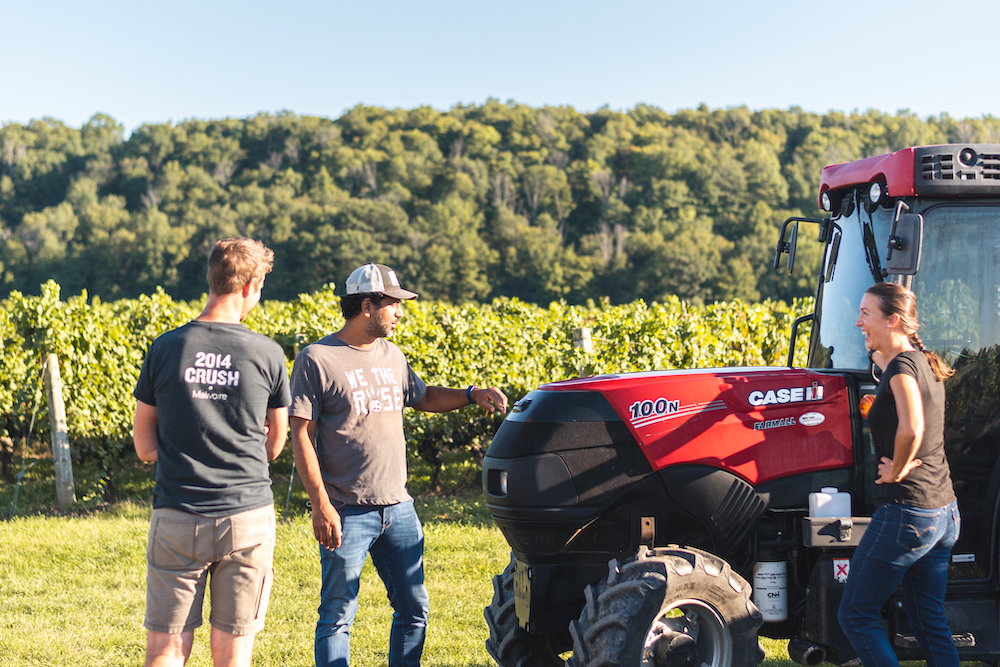
After the rain had cleared and the grapes were processed, many winemakers predicted there will be successes in 2021. Riesling that was picked early enough will be “stunning,” one winemaker said. The Chardonnays will be “racy and vibrant,” and the Cabernet Francs are “standing proud, a reflection of well-honed cellaring and aging strategies.” And other early ripening grapes, such as Pinot Gris, Sauvignon Blanc, Gamay and Pinot Noir are all showing “good aromatic intensity, balance and freshness at moderate alcohol levels.” And, of course, there will be plenty of really, really great rosé, a bit of an inside joke, but nonetheless, very true.
“If there’s ever a year the wine will tell the tale of the vintage this is definitely it,” said Peller winemaker Craig McDonald, “and one winemakers will either earn their stripes or chose another career!”
Those early-ripening varieties that were picked before most of the rain fell, will benefit from a decent season. But, with rain and humidity coming at inopportune times, it required a strategic and nimble approach to getting grapes in at their peak in all three main Ontario wine regions. It was a stop and start story in most of Ontario, with bursts of precipitation slowing the harvest and introducing disease pressures to be managed.
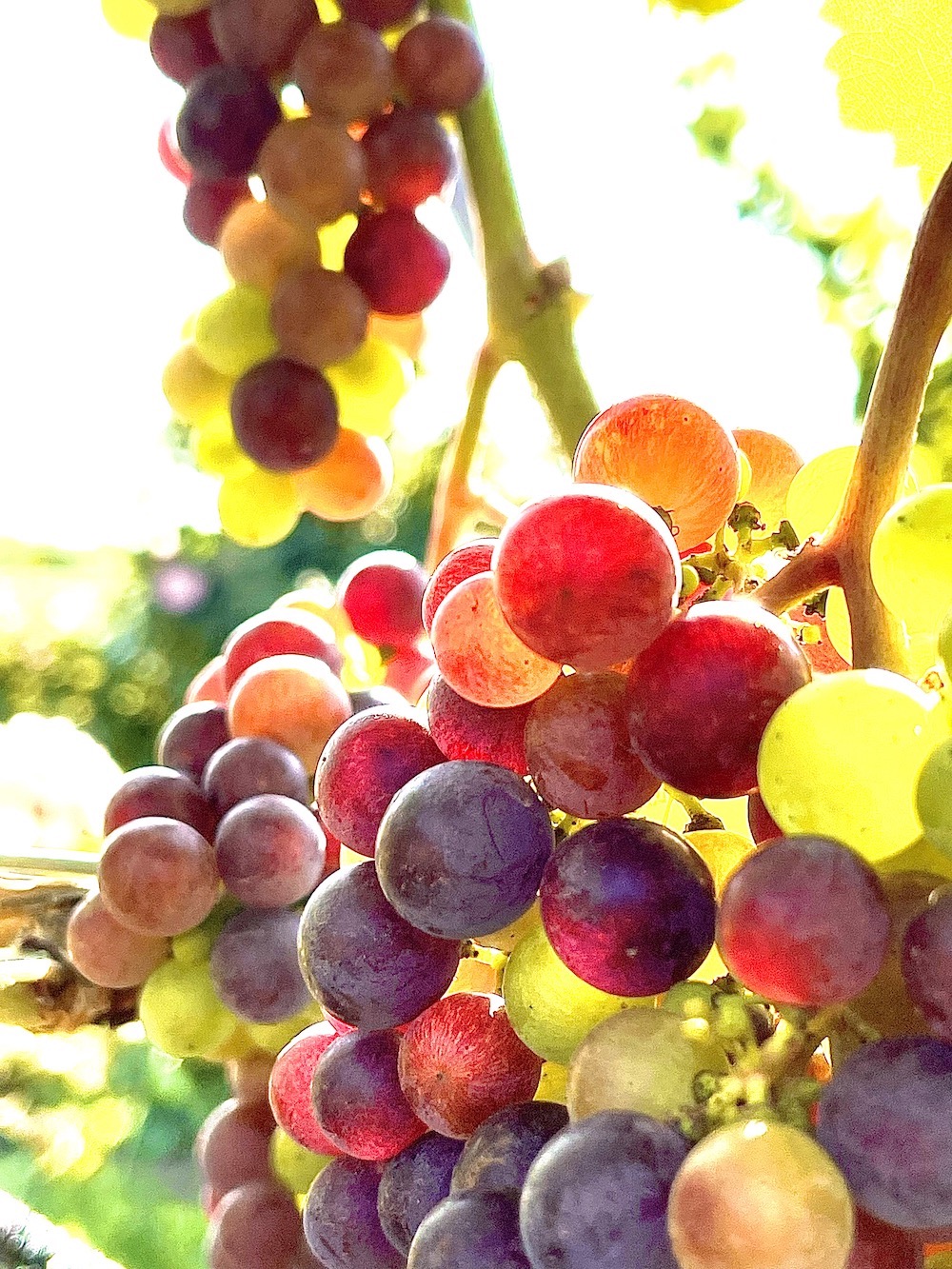
VQA Ontario said 2021 will be a good year for early white varieties that were harvested before the rains, notably aromatic whites such as Sauvignon Blanc and Riesling, and white varieties harvested for sparking programs. “Despite the weather challenges, most wineries reported good phenolic ripeness on skins and lower acid across many varieties, thanks to careful viticultural practices. Anticipate continued high quality red blends from varieties such as Cabernet Franc, Cabernet Sauvignon and Merlot,” VQA said.
We have been publishing this Ontario vintage chart for the past 13 years on Wines In Niagara. Our goal is to keep it updated, relevant and ever evolving as we keep tasting back vintages and new wines. Tweaking of descriptions, and even ratings, have occurred over time as we taste more vintage wines and, of course, the drinking window, not an exact science, is in constant flux.
New to the chart is a “tentative” rating for 2021, a more informed review of the 2020 vintage and updates on all the other vintages (mainly in the drinking window) back to 1998.
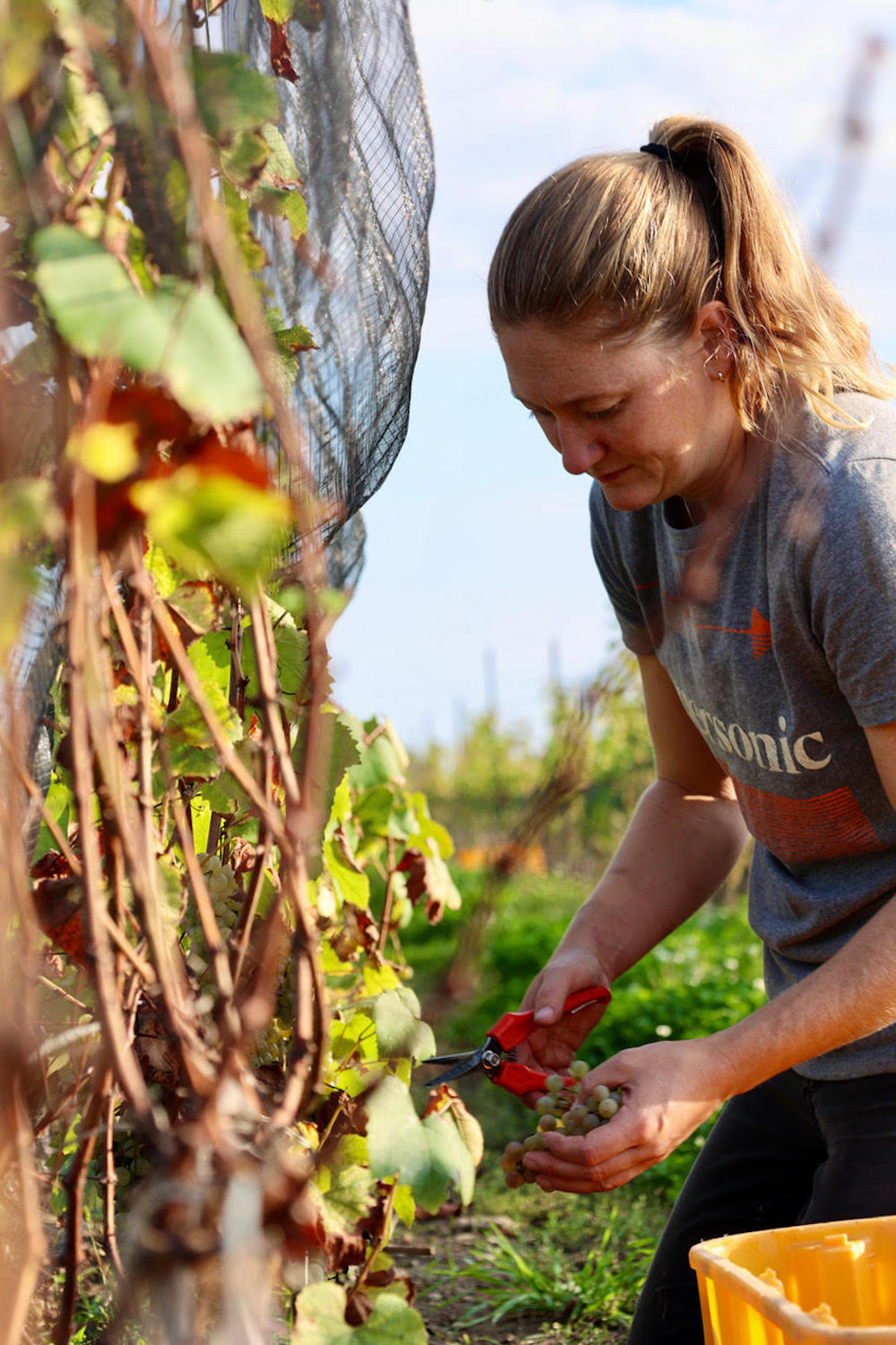
As with any rating system, the score is less important than the description of the vintage. That is especially true when discussing a region such as Ontario where so many varieties of grapes are grown. What’s good for the Bordeaux varieties isn’t necessarily good for aromatic whites and early ripening red grapes in any given vintage. It is rare that, in terms of wine quality, a year is a total failure or a resounding success in Ontario, unlike vintages in say, Burgundy or Bordeaux. Please keep that in mind when reading our assessments.
With that being said, the 2020 vintage reported a year ago, is the exception to the above statement. For various reasons, touched on in this report, the 2020 growing season provided ripeness for the Bordeaux red varieties, elegance and finesse for white wines and complexity and ripe tannins for varieties such as Pinot Noir.
And just to be clear, when cellaring your Ontario treasures, the drinking windows offered in the various vintage descriptions are likely understated because it’s far safer to offer you an earlier window than have you drink something well past its prime. The long-lived vintages of 2020, 2016, 2012, 2010, 2007, 2002 and 1998 enjoyed spectacular, near perfect weather for grape growing and gave winemakers the raw ingredients to make stunning wines for many years to come, especially in the bolder style wines. And while I have found pleasure in tasting the 1998s recently, I know it will be hit and miss depending on cellar conditions, producer, cork choices and many other factors. If you find a great one, be thankful, but don’t expect every bottle from these vintages will impress you.
I sadly have no 1998 bottles left in my cellar, but I do have a few from older vintages that I like to open every so often, mostly for reference, and I am often surprised at how long-lived Ontario wines can be. And I don’t mean they are merely drinkable, they can be so much better than when they were released.
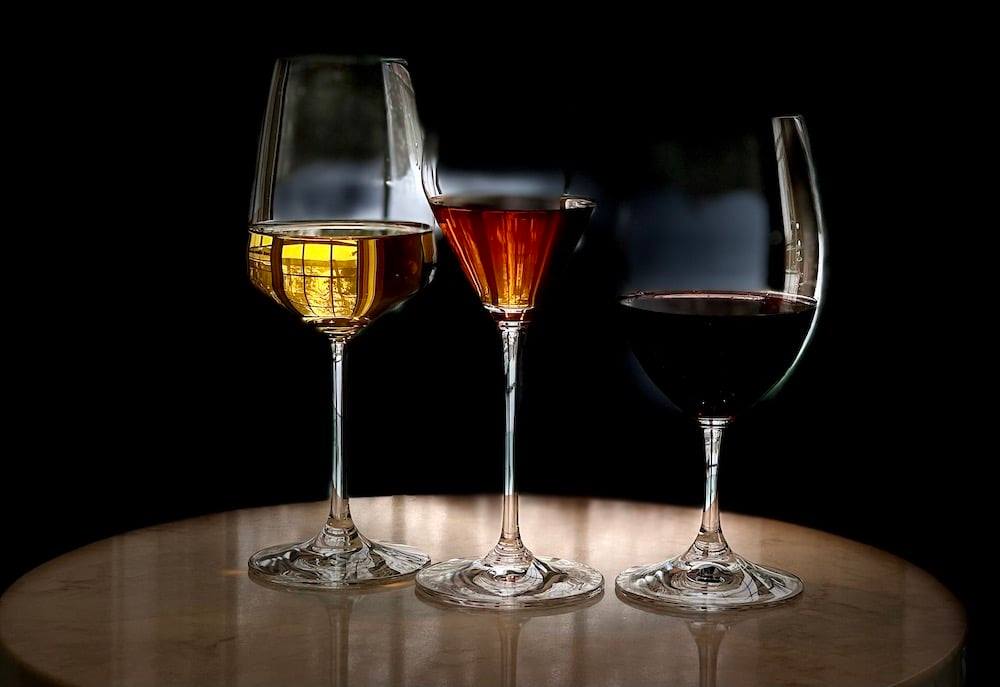
Before Christmas I opened three oldies, two of which pre-dated the 1998, the oldest vintage in my chart below. The wines tasted were a 1988 late harvest Riesling from Cave Spring, a 2010 Riesling from Charles Baker and a Chateau des Charmes Paul Bosc Vineyard Cabernet Sauvignon 1994.
The Charles Baker Riesling showed a deep golden colour in the glass and had a savoury nose of lemon tart, emerging petrol, grapefruit pith, peach preserve, ginger, and wet stones. It was rich and fleshy, complex, and profoundly altered from its original self on the palate. It opens up to a waxy/lanolin note and then a melange of mulled peaches, citrus marmalade, canned pears, ginger and more pronounced petrol and mineral notes. It’s a touch soft on the finish, as are a lot of 2010 Niagara wines, but still an interesting wine to judge against a new vintage.
The Cave Spring Indian Summer Riesling 1988, a late harvest wine picked at 24.7 Brix and finished with 55 g/l of residual sugar, was somewhat of a surprise as to how well it has held up. The ullage was low, and the cork pushed through the neck into the bottle when I attempted to free it, so it had to be filtered and decanted. But there was no leakage at all. It showed a deep caramel colour in the glass and had a rich and complex nose of dried apricots, sultana raisins, papaya, guava, and sweet canned pineapple. The tertiary flavours were on full display — caramel toffee, mulled peaches, butter tart with raisins, compoted tropical fruits, dry honey and brown sugar with a lovely freshness on the finish. Really interesting wine all these years later.
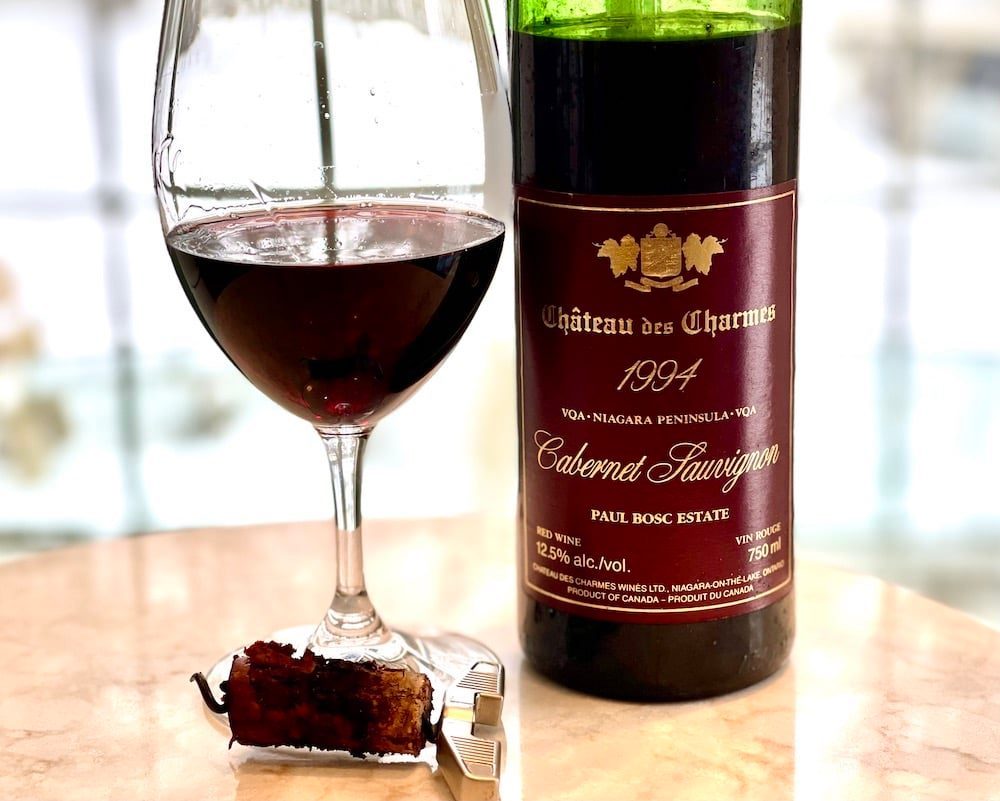
The 1994 Chateau des Charmes Paul Bosc Vineyard Cabernet Sauvignon was perhaps the biggest happy surprise. The fruit in this historic vintage was planted in 1983 and 1984 with the first harvest in 1988. The cork appeared as if it might pose a problem considering the layer of a dust-like substance under the cap, but it blew off and exposed a relatively sound cork. It had a bit of an odd odour at first of barnyard and compost, but then turned woodsier with a melange of red berries, kirsch, wild blackberries, integrated spice and oak notes with earthy/savoury undertones. It was quite pleasant on the palate with fully integrated, resolved tannins yet still vibrant and mature red berries, minty herbs, earthy accents, and the oak all but consumed by the fruit. Incredibly (or not) there was still plenty of lively acidity on the finish. Yes, they should have been consumed years ago, but fascinating to taste this Niagara red 28 years after the fruit was harvested.
The point is, as you cellar more and more of your favourite Ontario wines, let your palate be your guide. You are your best barometer for knowing when to drink your wines depending on your tastes. These charts are just a guide to get you going.
Ontario Wine Vintage charts
going back to 1998
2021 ★★★★★★½ (6½ out of 10, tentative)
Our tentative rating for 2021 is 6½ stars. That is on the lower end for vintages in Ontario, but in line with 2014, 2011 and 2006, all of which were impacted by a wet fall or a chilly growing season. There is no getting around 2021 as a less desirable vintage, but it doesn’t mean many wineries weren’t able to work through the drastically wet fall during harvest, it just means consumers will have to be vigilant when buying wines from 2021. There will be some nice ones, especially the early-ripening whites, rosé, sparkling wines, Gamay, some Pinots and Chardonnays, Cabernet Francs and even some Bordeaux varieties that came out the other side of the rains intact. Some varieties, such as Riesling, got caught in the middle of the rain and breakdown of the grapes, causing some wineries to abandon making their top single-vineyard wines. It was a matter of picking decisions, that in some cases, meant picking before the rains while the grapes had not yet achieved high enough Brix (sugar content) required by VQA. 2021 is a vintage that tested the skill of winemakers in the field and the decisions they made on the fly will determine the quality of their wines. Consumers will have to make buying decisions based on those producers they trust and taste for themselves before purchasing. There will be some very fine wines, but unlike 2020, where everything seemed to work out, you might want to be more selective. As for icewine, because the harvest was smaller and sales of Canada’s signature wine have plummeted due to COVID, pre-registration was up from last year, but still far off pre-COVID numbers. The first icewine grapes were harvested in mid-January and quality is yet to be determined.
Whites: We are just starting to see early rosés and other unoaked whites hitting the shelves. We anticipate early ripening whites will be excellent such as Riesling (picked before the rain), Pinot Gris, Sauvignon Blanc and Chardonnay (again, pre-rain), plus sparkling wines and rosés of all colours. Prince Edward County winemakers are pretty happy with their Chardonnay grown in the County.
Reds: Gamay, Cabernet Franc and Pinot Noir, not impacted by the rain, will be the superstars on the red side of things. The other Bordeaux varieties of Merlot and Cabernet Sauvignon will depend on how they fared through all the wetness and disease pressure. The jury is out on these varieties. Most wineries report an avalanche of rosés were made from red grapes, and we suspect a lot of the bigger reds were declassified blended into other red grapes. Prince Edward County reports good results from Pinot Noir.
2020 ★★★★★★★★★★ (10 out of 10)
Yes, you read that correctly. The 10 out of 10 rating for 2020 is a perfect 10 and we removed the “tentative” tag now that we are seeing more and more 2020s hitting the market. Last vintage report, 30 winemakers said they were confident that 2020 is the best they have seen in their winemaking careers in Ontario. There are few comparables. Yes, it was hot like 1998, 2002, 2007, 2010, 2012 and 2016, but 2020 was different; it was more favourable to all varieties across the board. It is the rarest of vintages when all grapes in Ontario (if picked at the right time) reach phenolic ripeness and maintain the acidity needed for balance, but, by all accounts, 2020, has both of those key ingredients as well as ripe tannins that will provide the structure and longevity in the red wines and offer complexity, elegance, body and freshness in the white wines across the board. While there were minor issues with early frost outside of Niagara and a crop 20% below normal levels across the board, by harvest the grapes benefited from ideal hang time, phenolic ripeness and each varietal was picked in optimum succession from beginning to end. It was a stress-free harvest and the one bright spot in an otherwise horrid year of COVID. Every winery we talked to is planning on bottling their top reserve reds, single-vineyard Pinot Noirs and Chardonnays. This is a vintage to buy and cellar. As for icewine, because the harvest was smaller and sales of Canada’s signature wine have plummeted due to COVID, very little was made in 2020, but what is being made should be sensational. Will prices rise on the top bottlings? I suspect they will be due to shortage of grapes and the quality, but I have no evidence that is the case. As Rosehall Run winemaker Dan Sullivan said: “When the 2020 Ontario wines start being released run, don’t walk, to your nearest tasting room or online winery store and buy as much as your wallet can handle. Good fortune awaits the astute.” Sage advice, to be sure.
Whites: The early whites and rosés have lived up to their predictions — fruit-packed, elegant, fresh, and lively. The Rieslings, Chardonnays and Sauvignon Blancs are showing much more wonderful concentration and complexity than previous vintages and are candidates for the cellar.
Reds: We won’t see the top Bordeaux varietals and Pinots for a bit, but the ones that have emerged to date are living up to the hype. Concentrated Bdx blends, rich and textured Pinots, up-front Gamays and simply some of the best Cab Francs to date in Niagara. The bigger reds will prove to be long-lasting, cellarable examples that will rival those from 1998, some of which are still going strong today. You will want to buy and hold the top examples.
2019 ★★★★★★★ (7 out of 10)
You hear it a lot in Ontario — that was the wildest harvest ever! Well, in 2019, it truly was the craziest growing season in a very long time. A wet, cool spring put everything behind by about two weeks. Summer brought typical weather with normal temperatures across Ontario and the growing season got under way. Flowering occurred quickly as the grapevines accelerated their growing but struggled to make up for the late start. July was warm and sunny, punctuated by intense heat waves and high humidity. August was warm and intermittently stormy, leading into a comparatively quiet September, cool with some rain – but bringing decent conditions to finish off the summer and begin the harvest season. Early ripening grape varieties escaped the wild weather of late fall and especially an unusually early cold snap in mid-November. Yield reductions were common for many of the red varieties to ensure optimal ripeness, particularly for later maturing varieties. Harvest extended into early December, sometimes taking place in the snow. The first icewine grapes were picked on Nov. 12, well before a lot of the red Bordeaux varieties. White wines are the superstars of the vintage with crispness, ripe fruit and finesse. Early ripening reds such as Pinot Noir are proving to be beautiful, built in the vein of the 2009s. The fuller-bodied reds will depend on the winery, winemaker and picking decisions (and, perhaps, technology). The verdict is still out, as not many of the finest examples have been released. One thing is certain, there will be no lack of freshness in Ontario wines from 2019.
Whites: Drink or hold aromatic whites (can hold Rieslings 3+ years), drink or hold Chardonnay (5+ years)
Reds: Drink Gamays (or hold a year or so), hold Pinots, hold Bordeaux varietals a couple of years or top examples, 5+ years.
2018 ★★★★★★★★ (8 out of 10)
Having now tasted most of the 2018 reds and whites, I have upgraded the overall score on the vintage to 8 out 10 stars. These are wines with freshness, depth and complexity, generally speaking. It was an ideal summer; hot, dry and long, sunny days. Everything was ahead on the ripening front, and it appeared to be another 2016 or 2012. But heavy rain and thundershowers mid-harvest turned the vintage on its ear and left many growers and winemakers with tough decisions to make in the vineyard (not to mention dog tired). In some cases, it was a choice between saving one variety over another. The quality of the wines entirely depends on what decisions were made — not only in the vineyard but also in the winery. Most wines made with grapes harvested before the rains began are exceptional. Those wines made with grapes harvested after the rains began must viewed through a different lens and assessed on a wine-by-wine basis. Winemakers feel the wines they have are of good quality. The wines are tasting better than I anticipated, though there are low yields in many varieties.
Whites: Drink aromatic whites (but hold Rieslings 2+ years), drink or hold Chardonnay.
Reds: Drink Gamays, hold Pinots, Bordeaux varietals (up to five years).
2017 ★★★★★★★½ (7½ out of 10)
All summer long it looked grim for the 2017 grape harvest in Ontario with cool, wet weather and the odd hailstorm thrown in very good measure. Then Sept. 1 rolled around, bringing extended heat and sunshine for one of the nicest falls on record and one of the latest harvests on record. The extra hang time for the grapes provided some needed ripening (in some cases right into December) and turned a potentially disastrous vintage into a good one. It was also a record harvest in terms of tonnes of grapes harvested. It resulted in excellent quality for aromatic white wines and good to excellent results for Pinot Noir, Gamay and Cabernet Franc. A few wineries declassified their top Bordeaux-varietal-based red grapes (so watch for the lower tiered reds to benefit from those grapes). As the whites and some reds have been released, I have been impressed with the quality. It would appear Ontario fully recovered from the back-to-back winter-kill years of 2014-2015.
Whites: Drink aromatic whites (can hold Rieslings 3+ years), drink or hold Chardonnay.
Reds: Drink Gamays, hold or drink Pinots (5+ years, hold Bordeaux varietals (5+ years).
2016 ★★★★★★★★★½ (9½/10)
Winter in 2016 was mild and drama-free for grape growers in Ontario. By mid-May, the vintage settled into a sustained pattern of much drier and slightly warmer than normal. Drought in some areas was a concern in some parts of Ontario. The hot, dry conditions prevailed throughout August, with lots of sunshine and just enough rain to keep drought conditions from becoming too severe. Targeted irrigation was required to sustain the young vines planted to fill in sporadic damage from the cold 2014 and 2015 winters. Weather conditions were very similar in all appellations except for a short but major rain event in Lake Erie North Shore in September. In all, the growing season presented outstanding opportunities for grape quality across Ontario. Harvest was early in all regions for all varietals and was stress-free with dry conditions and limited disease pressures. It was the perfect recipe to provide an excellent vintage. Virtually all grape varieties performed well in 2016 and were picked in pristine condition. This is a year to buy and hold those bigger red wines (Bordeaux varietals, Syrah, etc.) that will age gracefully for 10 years or more. The Chardonnays are generally more robust than in cooler years and Pinot Noirs more complex. Rieslings will be riper and have immediate appeal. Across the board, this is a great vintage along the lines of 2012, 2010 and 2007 and a good bounce back from 2014-2015, even if the tonnage was not quite back to normal. You can buy most varietals and blends with confidence.
Whites: Drink/hold Rieslings, drink Pinot Gris, Sauvignon Blancs; start drinking Chardonnays but some can hold a bit.
Reds: Drink Gamays, hold Pinots 1-2 years, hold on to bigger reds (save some for extended cellaring). This is a breakout year for appassimento-style reds, hold for a little longer.
2015 ★★★★★★★ (7/10)
This was the second half of two brutal winters that caused a great deal of hardship and soul searching for winemakers and grapes growers in Ontario. Record-breaking cold in the winter of 2015 was not what was needed after the horrible conditions of 2014. Many acres of grapes needed to be replanted and wineries had to make tough decisions of what not to plant in their terroir. The summer growing season brought good conditions with few major storms and sunny warm weather in all appellations. Niagara was slightly drier than Prince Edward County and Lake Erie North Shore. September weather settled nicely into warm beautiful conditions for the start of harvest and, except for some rainy periods in October, fall weather was favourable. Harvest conditions were excellent and good weather prevailed for much of the harvest period. Overall, grape production across the province was moderately less than normal but slightly more than 2014 when tonnes harvested was substantially less than previous years. Cold temperatures in January and February resulted in markedly reduced crop yields in Lake Erie North Shore, and less than full production in Niagara Peninsula and Prince Edward County. Tender grape varieties were in short supply. The irony of the vintage, devastating winter kill aside, is that it all averaged out by harvest and created conditions that allowed Ontario’s classic varieties — Riesling, Cabernet Franc, Pinot Noir and Chardonnay — to show well. Look for good concentration of flavours for the later ripening varieties that profited from the warm, dry summer and fall. In all, 2015 wines fared much better than 2014 wines, despite both vintages suffering through some of the most severe winter conditions seen in Ontario.
Whites: Time to start drinking Rieslings and Chardonnays (maybe hold a few of the top examples), drink the rest.
Reds: Drink Pinot Noirs and Cabernet Francs, start drinking red blends and finish the Gamays. Syrah can be held for a year or consumed now.
2014 ★★★★★★ (6/10)
The year was highlighted by a brutal winter that ultimately caused wide-spread bud damage leading to vine death in several varieties including (but not limited to) Syrah, Merlot, Semillon and Sauvignon Blanc. Couple that with a cooler year that always seemed a couple of weeks behind, varieties such as Cabernet Sauvignon and Cabernet Franc were tested. It is not a year for big red blends, but, on the bright side, the early-ripening Riesling, Chardonnay, Pinot Noir and Gamay enjoyed a very nice harvest and should provide some decent wines from the vintage. Look for de-classified reds from wineries with a trickle-down portfolio, good to excellent Riesling, Pinots, Chards and Gamays. I have spoken to many winemakers who did not make their top red blends in 2014 and many others who replanted their damaged and dead vines with varietals more suited to all weather conditions in Ontario. Wines from Prince Edward County weren’t hit as bad as Niagara and Lake Erie North Shore for two reasons: They bury their vines, and they don’t grow that many varietals outside of Chardonnay and Pinot Noir.
Whites: Drink soon, hold only top Rieslings and maybe some top Chardonnays.
Reds: Early drinking reds, for the most part, drink up. Check on bigger reds, but not built for the long haul.
2013 ★★★★★★★½ (7.5/10)
It was a late start to the season with every kind of weather imaginable tossed into the equation. Hot, cold, wet, dry … it was a rollercoaster ride, especially in Niagara. When it was all said and done, the season played to each region’s strengths — Chardonnay, Pinot Noir, Riesling and Cabernet Franc in Niagara, Pinot and Chard in Prince Edward County and early ripening varieties in Lake Erie North Shore. Most aromatic whites across the board have shown promise in 2013. Quality is spotty for the other Bordeaux varieties, Cabernet Sauvignon and Merlot, and anything that was left out on the vine to ripen late. I would call it a typical vintage for Niagara that plays to the strengths of what the region does best but some of the top bottlings, especially in big reds, have been de-classified. It was a record crop both for table wines and icewine grapes, which could come in handy for 2014 after a severe January cold snap caused wide-spread damage to vines, mostly in Niagara and Lake Erie North Shore.
Whites: Drink now, Rieslings 1+ year.
Reds: For near-term drinking, for the most part.
2012 ★★★★★★★★★½ (9½/10)
The mood in Niagara during the early harvest of 2012 was one of pure joy. Ripe fruit in pristine condition after a long, hot summer and early fall sent grape pickers into the vineyards in mid-August to harvest early ripening varieties. It was one of the earliest harvests on record for all varieties with only a slight hiccup during a brief rainy period in September. Reports from all regions in Ontario indicated a near-perfect season with the Bordeaux-style red grapes leading the way. Winemakers were also excited by the white grapes, especially Chardonnay, Riesling and Sauvignon Blanc, that all showed both juicy ripeness and natural acidity. The largest icewine crop was netted since 2007, an indication that Canada’s most famous export was set for a rebound in 2012. Since first writing this report I have now tasted most of the key 2012 reds from this vintage and have re-evaluated many of the whites. I have upgraded the rating from 9 stars to 9½ because I feel strongly that 2012 will prove to be the best vintage Ontario has ever encountered to date (that is, until 2020 came along). It’s not just the big red wines that are showing such promise, but all varieties across the board. Sort of unheard of until now. My suggestion, buy what you can from 2012 and cellar what you can, it’s as good as it gets in Ontario. Drink 2013s and 2014s while you wait.
Whites: Drink now, or cellar 1-2 years especially Riesling. Time to dig into those ripe Chardonnays.
Reds: Cellar 2 years or more, Bordeaux blends 3-6 years.
2011 ★★★★★★½ (6.5/10)
The extremely wet fall, during the peak of harvest for most varieties, meant careful buying strategies. Quality varied from winery to winery, and it depended a lot on picking decisions that were made. Pinot Noir, Gewürztraminer, Baco Noir and Cabernet Franc escaped the worst of the wet harvest, while Chardonnay was hardest hit. Late-harvest and icewine Rieslings were also affected by late-season rain. There are some very nice wines from 2011, however. Shop carefully. I have tried a few 2011s recently and downgraded my original rating by a half-point.
Whites: Drink now
Reds: Start drinking them up
2010 ★★★★★★★★★ (9/10)
Winemakers across Ontario have never been happier with a vintage. The harvest started in the extreme heat of August and continued without concern through October. The red varieties, especially Cabernet Franc, Cabernet Sauvignon and Merlot, are some of the best grapes grown in Ontario and should age gracefully. Even some of the whites show wonderful complexity, without being too flabby and soft. You can consume most Ontario wines from 2010 with confidence.
Whites: Drink now
Reds: Cellar up to 2 more years for Bordeaux varietal blends, or drink now. The very top bigger reds can stand a bit more cellaring.
2009 ★★★★★★★ (7/10)
In many ways, 2009 was like 2008. A cool, wet summer put the harvest up to 14 days behind for most red varieties, but a long, warm fall saved the vintage. Aromatic whites, particularly many exceptional Rieslings, are the stars of the vintage, along with the fabulous pinot noirs that are proving to be the best in recent memory. Bordeaux varieties had trouble ripening, especially Cabernet Sauvignon. Many wineries didn’t make their top red wines.
Whites: Drink now, Rieslings can cellar for a couple more years or drink now.
Reds: Drink now.
2008 ★★★★★★★½ (7.5/10)
It was a wet growing season in Ontario, especially in Niagara and Prince Edward County, and grape ripening in all appellations was a challenge. The quality of this vintage depended entirely on vineyard management. Whites and cool-climate reds (Pinot Noir and Gamay) fared better than other varieties. The ’08 Rieslings and other white varieties are superb, but consumers should be selective with the reds. Complex Chardonnays are the stars of the vintage.
Whites: Drink now (or more if you like that nice vein of petrol in your Rieslings)
Reds: Drink now.
2007 ★★★★★★★★★½ (9.5/10)
The growing season across Ontario was just about perfect. The 2007 vintage was the best in Ontario’s history, up to this point. It was warm, dry and ideal for extended hang time on the vines. The 2007 whites showed beautiful concentration of flavour but lacked acidity and fell apart quickly. The red wines are proving extraordinary, especially with some age on them, from variety to variety. Look for rich, ripe, concentrated Bordeaux-style reds built to last. I tasted a Henry of Pelham Reserve Cabernet/Merlot 2007 in February 2021, and it blew me away. It still has the stuffing to another 5+ years.
Whites: Drink now, fading fast and drying out.
Reds: Drink now (but some examples are still evolving nicely).
2006 ★★★★★★★ (7/10)
Not as wet as 2008, but still humid and slightly cooler than normal. The mood was upbeat in Ontario as vines recovered from the terrible winterkill of 2005. There was plenty of sunshine in August, but a wet September meant wineries had to employ good vineyard selection. It was a decent year for Chardonnay, Riesling, Merlot, Gamay, Cabernet Franc and Pinot Noir, and a great year for icewines.
Whites: Drink now
Reds: Drink now
2005 ★★★★★★★ (7/10)
This was a disastrous year. An extremely cold winter killed any hope for a healthy vintage, with more than half of the vintage wiped out. Many producers didn’t have enough wine to sell and suffered hefty financial losses. Both Lake Erie North Shore and Pelee Island fared better than Niagara. The irony of the vintage was that, even with a tiny crop, what was grown ended up being pretty good.
Whites: Drink now
Reds: Drink now
2004 ★★★★★★★ (7/10)
The 2004 vintage was a major relief for producers following the bad winter of 2003. Conditions improved immensely, and vines recovered from the previous winterkill. Some of the stars of the vintage include Riesling, Chardonnay, Pinot Noir, Cabernet Franc and Gamay. Tender varietals didn’t fare nearly as well.
Whites: Drink now
Reds: Drink now
2003 ★★★★★★★½ (7.5/10)
This vintage had it all: a horrible winter resulting in another short crop (a reduction of 45 per cent of all vinifera vines), the reappearance of the Asian lady beetle (which causes a nasty taint in wines) and, despite all of that, the emergence of some mighty fine whites. The rating for this vintage is really split between red and white wines: a 6.5 for red wines and an 8.5 for whites.
Whites: Drink now
Reds: Drink now
2002 ★★★★★★★★★ (9/10)
A lot of winemakers rank this vintage up there with 2007 and 1998. This vintage was highlighted by severe drought conditions in all Ontario appellations for most of the summer. The resulting grapes ripened beautifully, with small, concentrated grapes, high sugar levels and tannins. A tasting of top 2002 cab-merlots in 2010 showed just how wonderful most of these reds have come along. Most are just now coming into balance and show wonderful fruit, spice and tannins.
Whites: Drink up
Reds: Drink up, but some Bordeaux blends still holding on nicely, if you like mature wines.
1998 ★★★★★★★★★ (9/10)
The best examples from this benchmark vintage are still showing beautifully. The whites have faded, but only just recently. This is considered by many to be the vintage of the last century and the most significant vintage in Ontario’s history (2020 has eclipsed it, however). Recently opened bottles from this vintage are superb. The top Bordeaux-style reds continue to impress but all should be consumed now.


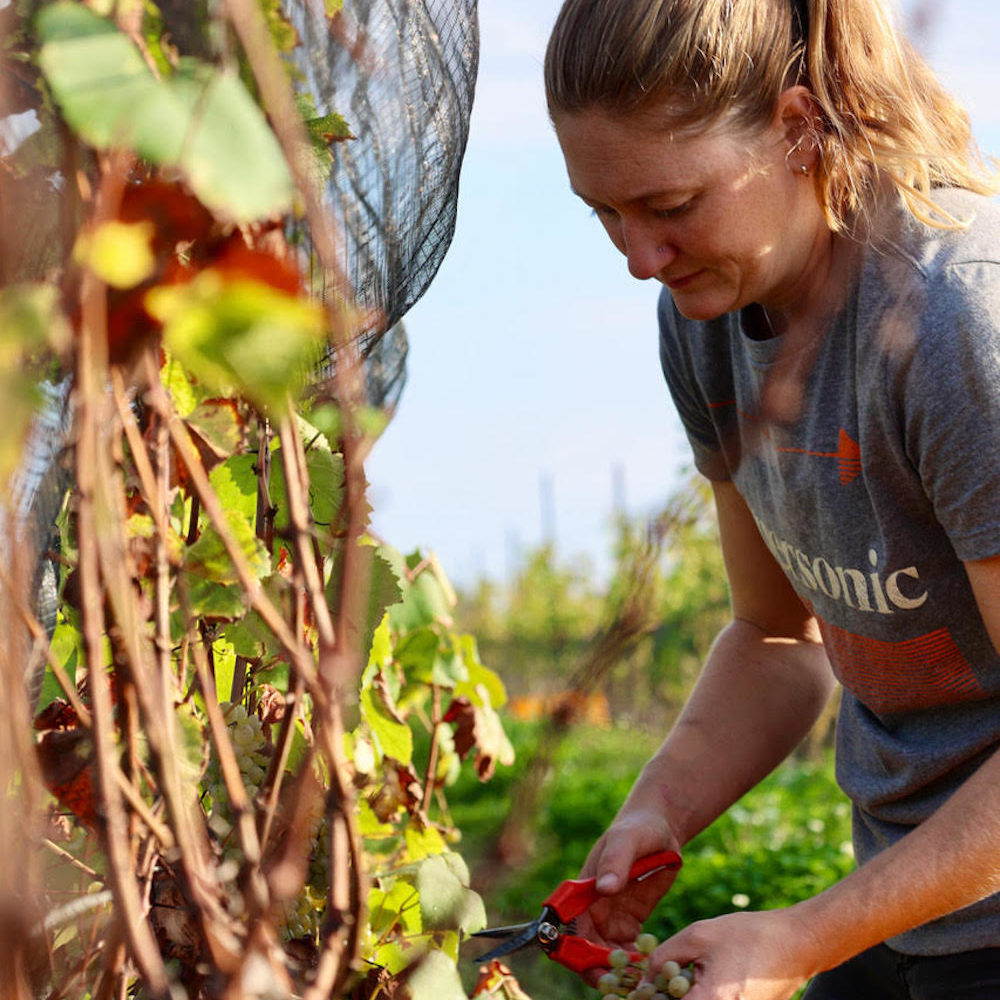




I am really enjoying the articles and the commentary on each vintage year. I’m always a bit confused, however, with the comment about cellaring for x years. If the comment says ‘can be cellared for 4 – 6 years’, is that from the vintage year? Or from the release date? Would it not be best to use a year as in – cellar until 2026. I realize that this date would just be a best guess but surely better than the less useful, ‘cellar for another 5 years’.
Thanks for all the info you provide. My wife and I make annual visits to the Niagara region and love visiting different vineyards and I always end up ordering a few cases through the year.
Thanks
Ralph
Ralph, to answer your question, it is from this point forward. The chart is updated annually to reflect best-guess information. I will have to think about your suggestion for actual dates, but the same will apply. That will need updating annually as well. Or at least consideration for updating. Thanks, Rick
Rick, I get it that dates might need to be updated once wines age somewhat and are re-evaluated related to ‘best’ drinking but if there was a ‘best by’ year it just seems to me that that would be less likely to be revised. Thanks for the clarification.
Ralph
Thanks, Ralph … will circle back on this for the next update. Thanks! Rick